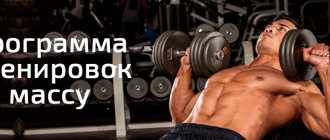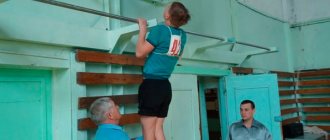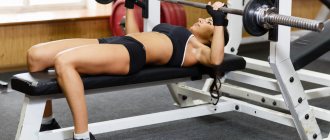Author: Timko Ilya - the ruler of the entire site and fitness trainer | more details >> Rod. 1984 Trained since 1999 Trained since 2007. Author and creator of the site tvoytrener.com. CCM in powerlifting. Champion of Russia and South Russia according to AWPC. Champion of the Krasnodar region according to IPF. 1st category in weightlifting. 2-time winner of the Krasnodar Territory championship in t/a. Author of more than 700 articles on fitness and amateur athletics. Author and co-author of 5 books.
Place in the ranking of authors:
out of competition
(become an author) Date: 2015-08-26 Views: 366,851 Rating: 4.7
| All articles by the author >> | Medals articles >> |
Articles are loading...
| Article medals: | more than 100 comments | more than 100 thousand views |
Why medals are given to articles:
| Bronze medal: | |
| 1. The article is in the TOP 100 2. The article has more than 3. The article has more than 100 | |
| Silver medal: | |
| 1. The article is in the TOP 50 2. The article has more than 3. The article has more than 500 | |
| Gold medal: | |
| 1. The article is in the TOP 10 2. The article has more than 1 3. The article has more than 1,000 | |
Goal of the plan:
weight gain
Plan objectives:
1. Increased muscle mass.
2. Increased muscle strength. 3. Strengthening ligaments. Execution methods:
supersets | apart
Duration:
about 4 months.
Why exactly so much >>
The fact is that the body gradually gets used to the same loads. And once you get used to it, the effectiveness of the training decreases. Therefore, it makes sense to do a one-week program (consisting of one week) for 2 months (3 is maximum). Two weeks - 3-4 months. Three weeks - 4 or even 5 months. Read more here.
Difficulty – above average
This complex, as the name suggests, consists of 3 different weeks, which you simply need to alternate. After 3 weeks have passed, we start again from the first week. And so on until you get tired of it. On average, the effective duration of this plan is 4 months.
In the first week, all exercises are done separately. 2 muscle groups per workout. The second week differs from the first in that the weights are taken here more and the number of repetitions is done less. That is, the amount of work decreases, but the weights increase. In addition, there are differences in the exercises. About 1/3.
The third week is performed with supersets for one muscle group. Here the weights are the smallest, since in supersets it is basically impossible to lift maximum weights. And the intensity of training is maximum. That is, we are working on pumping, and not on strength indicators.
A superset is two exercises under one number. For example, do 1 set of barbell squats, then immediately do 1 set of leg extensions in the machine without rest. Then rest for about 2-3 minutes and repeat all over again. And so on until you have done 4 such approaches. Then move on to the next couple of exercises.
Thus, from week to week there is a constant alternation of work on mass (pumping) and work on strength (heavy weights). All this will interfere with the adaptation of your muscles to loads, and therefore contribute to the constant growth of muscle mass.
Select the exercise weight for this program
| Best result so far: | The calculator will show you what weight you need to take. But this does not include exercises on machines, but only with free weights. It is not necessary to complete all exercises. If you specify the weight for fewer repetitions, the result will be more accurate. In exercises with dumbbells, the weight of 1 dumbbell will be indicated, and with a barbell, taking into account the weight of the barbell. | ||
| Squats | kg per | once | |
| Barbell deadlift | kg per | once | |
| Bench press | kg per | once | |
| Standing chest press | kg per | once | |
| Barbell Curl | kg per | once | |
| Push-ups from the floor / from the floor from your knees | once | ||
| Dips/bench push-ups | once | ||
| Straight grip pull-ups | once | ||
Data saved
Data deleted
You did not indicate the purpose of your training
You did not indicate the purpose of your training
Delete exactly?
| YES | NO |
Basic exercises for gaining muscle mass for men
The base is a series of elements that form the basis of any training, regardless of who we are talking about, professionals or beginners. The training schedule must include at least one exercise of this type. Beginning athletes can only use a clean base without insulating elements when pumping up their mass.
Basic exercises for the thoracic region:
- Lifting the barbell while lying down.
A multi-joint exercise that involves working with free weights and targets the chest muscles, triceps and frontal deltoids. Suitable for both beginners and experienced athletes.
Technique:
- lie with your back on the horizontal surface of a sports bench, firmly fixing your feet on the floor;
- bring and press the shoulder blade to the support, naturally bend in the lower back;
- with a wide grip, grab the bar of the projectile, which is at eye level;
- tighten your neck muscles and smoothly lower the barbell to your chest;
- after touching, lift the bar up, avoiding a skewing of the amplitude towards the legs;
- Fully straightening your elbows, hold for 2 seconds;
- lower the bar to the chest line again.
The breathing technique is as follows: exhale – rise – hold your breath – lower – inhale.
Features: you cannot linger at the bottom point or lower the bar to your chest (touch only), when pressing, you can push your legs harder without arching your lower back, you should not work with heavy weights at once.
Important! Beginners are recommended to perform their first presses under the supervision of a trainer or an experienced partner.
Quantity – 3-4 sets, each from 6 to 12 times.
- Bench press on an incline bench.
The muscles of the lower chest and the anterior deltas are worked out. This is one of the few exercises that allows you to overcome the plateau - the lack of growth in physical parameters and indicators.
Technique:
- sit on an inclined sports bench (35°-45°), grab the bar with a wide grip and straighten your arms with the apparatus;
- while inhaling, lower the barbell to the upper chest, touching and holding for 1 second;
- exhaling, squeeze the bar up, returning to IP.
Features: when squeezing, you must rest on your heels, maintaining a deflection in the lumbar area, the apparatus should not “walk”, its position should be strictly parallel to the floor, the rise should take 2 times longer than the descent.
The number of rounds is 3-4, each with 8-10 repetitions.
Also, a 3-day mass training session may include such basic elements as a bench press or dumbbell flyes and a pullover.
Basic three-day complex for beginners
This plan lasts for two months. The goal is to increase overall endurance and muscle strength.
Monday:
- crunches on a bench or on the floor;
- hyperextension – to strengthen the lower back, buttocks, and core muscles;
- squats with a barbell or dumbbells - to strengthen the hips, buttocks, and stabilizer muscles;
- Bench chest press – strengthens and develops the pectorals, biceps and triceps;
- pulling a vertical block behind the head or on the chest – development of the lats and upper back;
- lying down pullover – load on the lats and chest.
All exercises are performed 10-15 times in 4 approaches. Between approaches, rest no more than one and a half minutes, between different exercises - as much as is needed for recovery. The weight of the barbell for squats and bench presses is from 20 kg. The weight of dumbbells used is from 5 kg each.
Wednesday:
- lifting straight or bent legs in support - for the lower back and abs;
- classic push-ups from the floor or on parallel bars - development of pectorals, triceps, deltas;
- pulling the upper block to the chest with a narrow grip - load on the chest, biceps and triceps;
- French press – to strengthen the triceps;
- curling arms with dumbbells or a barbell - developing biceps;
- raising your toes – strengthening your lower legs.
If you have some strength left, you can add lying dumbbell flyes to your plan - another effective exercise for the chest. The program can be varied with other basic exercises. For example, change the base every week, or add different abdominal exercises.
Friday:
- hyperextension;
- deadlift with a barbell - works the lower back, hips and buttocks, forearms and upper back;
- lunges with dumbbells or a barbell in a Smith machine - development of the hips, buttocks, stabilizer muscles;
- standing chest press (barbell or dumbbells) - perfectly works the front and middle deltoids, triceps and forearms,
- stretching with a barbell - for the back and shoulders;
- Side swings with dumbbells - for shoulders, upper back and biceps.
The main rule is to complete the session with an isolated load on the lagging muscle groups. This could be lateral swings or bicep curls, calf raises or triceps curls.
Each workout begins with a warm-up and ends with a cool-down to stretch the targeted muscles. The number of repetitions and approaches of all exercises in the basic complex is 3-4 sets of 10-15 times.
Exercises to train the muscles of the back and legs
- Wide grip pull-up.
The exercise is aimed at developing many groups, but primarily the latissimus and biceps brachii muscles.
Technique:
- grab the bar with a wide grip;
- cross your feet and feel the tension in your abs;
- sharply tighten your chin, going beyond the line of the crossbar;
- hold for 2 seconds;
- slowly return to IP.
Alternatively, you can use a reverse grip. While swinging to the masses, you can try working with weights. To do this, you will need an athletic belt with a special suspension on which metal plates or weights are fixed. You can also use leg weights.
Number of sets and repetitions – 4/5-8.
- Deadlift.
Used to increase mass and strength. More than 70% of the muscles responsible for lifting weights or maintaining balance are involved in the process. Among them are the muscles of the back, buttocks, legs, hands, forearms, trapezius, abs and calves.
Technique:
- placing your feet slightly wider than your shoulder line, stand straight with your feet parallel;
- tilt the body (until an angle of 40-45° is formed), move the pelvis and create a slight deflection in the lower back;
- bend your knees and grab the bar with a standard grip (palms facing you);
- slowly straighten your legs first, then your back;
- hold for 2 seconds;
- return to the starting position.
Upon reaching the peak of the lift, the shoulder blades are brought together, and support is placed on the heels. As a warm-up, you can do 10-15 squats with an empty bar, and then move on to the main training of 3-4 sets of 6-10 repetitions each.
- Squats.
The gluteal, calf and thigh muscles are pumped, as well as the back (extensors) and abdominal muscles.
Technique:
- place the bar on top of the trapezoids, place your feet shoulder-width apart, tense your back, pull your elbows back;
- while inhaling, begin a slow squat, making sure that your toes do not go beyond the line of your knees;
- while inhaling, rise to IP.
Features: a deflection in the lumbar region should be maintained, the pelvis should be slightly retracted when lowering, the squat should be slower than the ascent.
Number of approaches – 3-5/6-10.
When increasing the mass of your legs and back, you should also take a closer look at the following basic elements:
- Bent-over barbell row;
- block pull behind the head;
- calf raises.
// Day 3: back and abs
The final day of training is based on working the back and abs. Lat rows and pull-ups develop the latissimus dorsi, while dumbbell rows and seated rows add thickness. Optionally, the training program may include deadlifts.
Pull-ups
Exercise to warm up the latissimus dorsi muscles. When performing, keep your abs in conscious tension, and at the top point, feel the work of your back muscles, pushing your body weight higher. Don't swing. 2-3 sets of 12-15 repetitions.
// How to learn to do pull-ups?
Upper block pull
By using additional weight, it allows you to perform a movement similar to a pull-up - but with more impact. Using different handles and grips allows you to modify the exercise and use different back muscles. 3-4 sets of 7-10 reps
// Lat Pulldown - Correct Technique
Dumbbell row to waist
Exercise to make your back muscles thicker. The goal is to engage the lats, not just lift as much dumbbell weight as possible using your arm muscles. Make sure your spine is straight and not arched (especially upwards). 3-4 sets of 7-10 repetitions.
Lower block thrust
If there is an opportunity in the gym to perform a full deadlift with a barbell, do the deadlift. Otherwise, the exercise can be replaced by pulling the lower block to the belt. 3-4 sets of 7-10 repetitions.
Bicycle press
Exercise to work the oblique abdominal muscles. It involves bending the leg at the knee and bringing the opposite elbow towards it. It is performed with a tense press and with a full feeling of involving the abdominal muscles in the work. 3-4 sets of 10-15 repetitions.
// Exercise “Bicycle” - what is the benefit?
Bench crunches
Exercises to develop the rectus abdominis muscles. When lifting up, do not hold your breath and make sure that the load does not transfer to the lower back and lower back. At the top point, tighten your abs even more. 3-4 sets of 10-15 repetitions.
Plank
The most important static abdominal exercise that develops the internal and transverse abdominal muscles. The plank is performed in a static mode - it is necessary not to repeat the movement, but to hold still. Alternate between different types (on the elbows, on outstretched arms, side). 3-4 sets of 60-90 seconds.
Hyperextension
Exercise to strengthen the lower back and lower back. It can be performed both dynamically and statically. As you rise up, be careful not to go too high, arching your spine back. 2-3 sets of 10-15 reps
// Hyperextension - technique and types
Basic exercises for the muscles of the arms and shoulder girdle
- Push-ups on parallel bars or horizontal bar.
During execution, the arms, chest and shoulders are pumped well.
Technique:
- fixate on the bar, cross your feet;
- while inhaling, slowly begin to lower until the elbow joints reach an angle of 90°;
- bringing your shoulder blades together, hold for 1 second;
- As you exhale, rise up, returning to IP.
Features: during push-ups, you need to tense your core muscles, press your elbows to your body, and strictly fix your shoulders.
Number of sets – 4 8-12 times.
- Barbell biceps press.
Exercise to increase the mass and strength of the forearms, frontal deltas, wrists and biceps.
Technique:
- grab the bar with a medium reverse grip, with your feet shoulder-width apart and your elbows close to your body;
- while exhaling, begin lifting the projectile using the traction force of the biceps;
- Having reached the shoulder line, fixate for 2 seconds;
- while inhaling, return to IP.
Features: quick rise and slow descent, smooth movement without jerking, no need to straighten your arms completely.
Number of rounds: 3 x 6-10 repetitions.
- Pull to the chin.
An element aimed at pumping the triceps brachii muscle.
Technique:
- standing up straight, place your feet shoulder-width apart;
- take the bar with a reverse grip;
- bend your arms, starting to move your elbows from your hips upward and pulling the bar towards your chin line;
- fixate at the peak point for 2 seconds;
- return to IP.
Features: straight back with a natural arch in the lower back. Number of sets – 3-4, repetitions in each – 8-12.
- Shrugs.
One of the most productive exercises for working the muscles of the shoulder girdle and trapezoidal fascicles.
Technique:
- take the dumbbells with a grip towards you, placing your arms at your sides, straighten your body;
- while inhaling, quickly raise your shoulders as high as possible, while lowering your head;
- hold for 2 seconds;
- As you exhale, smoothly return to IP.
Number of approaches – 3-4, 12-14 repetitions each.
Exercises such as:
- press from behind the head or with a narrow grip;
- bent over dumbbell raises;
- French press;
- lifting dumbbells for biceps.
Full body workout program for beginners: 3 days a week.
If you have just started training and have already mastered the technique of performing basic exercises well, this full body program is ideal for gradually adapting to subsequent increased loads.
For beginners, it is a good idea to work all muscle groups in one workout using basic, strength-based exercises, which indicates potentially greater muscle hypertrophy when using more frequent training sessions in a weekly cycle.
The training program below is typical or basic and is not intended for specialized training. From there, you'll begin training with your own customized programs that best suit your experience, fitness level, goal, and weekly schedule.
Never imitate or apply the programs of advanced athletes to yourself, even if you have already gained sufficient experience in training.
And even taking into account productive nutrition, hard training and sufficient rest for recovery, it is more realistic to gain from 10 to 15 kg. muscle mass only after two years of regular training, of course it also depends on the type of body build, but nevertheless. This is my personal observation.
- Duration of the program: from 4 to 6 weeks.
- Training per week: 3 days.
- Training days: Monday, Wednesday, Friday.
- Approaches in exercises: from 2 to 3.
- Rest between sets and exercises: 2 minutes.
Full body training program
Monday.
1. Crunches lying on the floor - 2/3 sets of 12 - 15 repetitions.
2. Barbell press on a horizontal bench – 2/3 sets of 8 – 12 repetitions.
3. Barbell squats – 2/3 sets of 8 – 12 reps.
4. Wide grip lat pull-down – 2/3 sets of 8 – 12 reps.
5. Horizontal row on a block with a narrow grip – 2 sets of 8 – 12 repetitions.
6. Seated dumbbell press – 2 sets of 8 – 12 reps.
7. Lifting the barbell for biceps – 2 sets of 8 – 12 repetitions.
8. Extension of arms from the upper block – 2 sets of 8 – 12 repetitions.
Wednesday.
1. Reverse crunches lying on the floor - 2/3 sets of 12 - 15 repetitions.
2. Incline bench press – 2/3 sets of 8 – 12 reps.
3. Leg press - 2/3 sets of 8 - 12 repetitions.
4. Lying leg curls – 2/3 sets of 8 – 12 repetitions.
5. Close-grip lat pull-down - 2/3 sets of 8 to 12 reps.
6. Standing dumbbell raises – 2 sets of 8 – 12 repetitions.
7. Raising dumbbells for biceps “hammer” - 2 sets of 8 – 12 repetitions.
8. French bench press - 2 sets of 8 - 12 reps.
Friday.
1. Oblique crunches – 2/3 sets of 12 – 15 repetitions.
2. Dumbbell press on a horizontal bench - 2/3 sets of 8 - 12 repetitions.
3. Leg extensions in the simulator – 2/3 sets of 8 – 12 repetitions.
4. Barbell row on straight legs - 2/3 sets of 8 - 12 repetitions.
5. Horizontal row on the lower block - 2/3 sets of 8 - 12 repetitions (use wide grip)
6. Barbell row to the chin - 2 sets of 8 - 12 repetitions.
7. Biceps Curls on Scott Bench – 2 sets of 8 – 12 reps
8. Sitting overhead dumbbell extensions - 2 sets of 8 - 12 repetitions.
Note. As your training level increases, the volume of load should increase and the frequency of training should decrease. So, after training for the whole body, a transition is made to training the upper/lower body, that is, half of all muscle groups being developed. This can be done in a two-day split. For example:
- Day - 1: upper body.
- Day - 2: lower body.
- Day - 3: rest.
- Day - 4: upper body.
- Day - 5: lower body.
- Days - 6, 7: rest
Three-day workout option for relief of all muscle groups
A classic program of exercises for relief will allow you to work your muscles for 3 days a week.
The first stage of any workout, regardless of its purpose, should be a warm-up. It consists of 3 parts:
- Increasing body temperature, accelerating blood flow (jumping rope, treadmill, cardio equipment).
- Warming up ligaments and joints (rotation of arms, shoulders, legs).
- Stretching (squats, lunges, bends).
A good warm-up should not take less than 7-10 minutes.
The training plan for relief is the following diagram:
Day I (chest and arms):
- Bench press from a lying position (4 sets of 10-15 repetitions).
- Dumbbell flyes (4/12-15).
- Push-ups (4 sets to maximum).
- Reduction of hands on the block (4/12-15).
- Bent-over dumbbell rows (4/12-15).
Day II (legs and shoulder girdle):
- Barbell squats (4/12-15).
- Lunges with dumbbells (4/15).
- Leg bending on a machine from a lying position (4/15).
- Standing barbell press (4/12-15).
- Swing dumbbells in front of you (4/12-15).
- Arm fly (4 sets to maximum).
Day III (back and biceps):
- Bent-over barbell lift (4/12-15).
- Dumbbell rows (4/12-15).
- Pull-ups (4 sets to maximum).
- Barbell curls for biceps (4/12-15).
- EZ-bar pull (4/12-15).
Important! You need to finish your workout with a final stretch. Due to it, blood flow increases, and muscles recover faster. Cool down time – 2-5 minutes.
First week (separately with average weights)
Workout 1 (legs and shoulders)
- 8000
- Hanging Leg Raise
| 3x10-12 |
23,275
- Hyperextension
| 3x10-15 |
10,272
- Squats
| 4-6x8-12 |
12,294
- Leg press in the gym
| 4x10-12 |
2,340
- Standing chest press
| 4-5×10-12 |
39,231
- Seated dumbbell press
| 3-4x10-12 |
16,78
- Swing dumbbells to the sides
| 3×10-15 |
40,233
9000
General video
| Total load |
f4zFb23vObQ
Workout 2 (back and chest)
- 8001
- Roman chair crunches
- Barbell deadlift
- Classic bench press
- Dumbbell flyes at an upward angle
- Wide-grip chest pull-ups
- Bent-over barbell row
- Lever traction in the simulator
| 3x12-18 |
83,324
| 4-5×6-10 |
38,273
| 5-6×10-12 |
33,219
| 3×10-15 |
80,222
| 3-4x10-15 |
79,134
| 3-4x10-12 |
59,258
| 3x10-12 |
150,985
9001
General video
| Total load |
4u6gcVQjtoo
Workout 3 (biceps and triceps)
- 8002
- Hyperextension
- Crunches on an inclined bench
- Dips
- French bench press with dumbbells
- Extension of arms from the upper block
- Reverse grip pull-ups
- Hammer dumbbell curls
| 3x10-15 |
100010,272
| 3x12-18 |
1,326
| 4-5x10-15 |
25,240
| 3x10-15 |
103,256
| 3x10-15 |
67,311
| 3-4x10-15 |
26,262
| 3x10-15 |
75,252
9002
General video
| Total load |
uucMVnSkZ5s
Weight loss program
Losing weight is possible through a combination of a balanced diet and a progressive set of physical activities.
A training program that allows training 3 times a week begins with a warm-up warm-up. The complex itself includes:
- Crunches (3/25-30). Abdominal muscles work.
- Side lunges (3/10-12). The buttocks and thighs are pumped.
- Plie (3/20). The inner thigh area is loaded.
- Push-ups (3/10). The arms and pectoral muscles work, and the posture straightens.
- Dumbbell flyes from a lying position (3/15-20). The chest muscles are tightened.
Also, we must not forget about drinking regime and aerobic exercise.
Gym training program
Training in the gym 3 times a week involves dividing the body into segments that combine different muscle groups. On the first day of the program, chest, biceps and leg exercises are combined. Since chest work doesn't involve your lower body, the second part of the workout allows you to work your legs.
On the second day, the muscles of the upper body are combined - triceps, shoulders and trapezius, while the chest and legs worked in the previous workout receive recovery. On the third day of the gym, it is necessary to pump up your back and abs - when working the back muscles, the biceps are also involved, but a sufficient amount of time has passed since its last workout.
// Pros of 3 workouts per week:
- develops mass and volume of the upper body
- suitable for cycle training
- great emphasis on the abs
- Convenient schedule (Mon, Wed, Fri)
// Minuses:
- reduced emphasis on leg muscles
- not suitable for ectomorphs or beginners
- implies a high level of load
- may lead to overtraining
Recommendations for organizing training time and recovery for beginners
When drawing up a training schedule for beginners, the following goals should be at the forefront:
- improved endurance;
- development of muscle coordination;
- increased performance.
Only after this can the goal be to improve strength or volume indicators.
General recommendations for the program for beginners include:
- training 2-3 times a week;
- mandatory warm-up before and stretching after;
- comprehensive training of all muscle groups;
- use of basic exercises;
- smooth progression of loads and weights;
- inclusion of elements for flexibility;
- regular cardio training.
By following these simple tips, you can achieve good results without getting any injuries.
Second week (separately with heavy weights)
Workout 1 (legs and shoulders)
- 1118000
- Leg raises
- Hyperextension
- Squats
- Lunges with a barbell
- Squats in the HAKK-simulator
- Standing chest press
- Seated dumbbell press
| 3x10-12 |
11,327
| 3x8-12 |
200010,272
| 4-6x5-6 |
100012,294
| 3x8-10 |
62,289
| 3-4x6-8 |
66,331
| 4×8-12 |
100039,231
| 4x6-10 |
100016,78
1119000
General video
| Total load |
zJvax4pJ0gI
Workout 2 (back and chest)
- 1118001
- Crunches lying on the floor
- Barbell deadlift
- Classic bench press
- Dumbbell bench press at an upward angle
- Wide-grip chest pull-ups
- Horizontal block thrust
- Pullover with dumbbells lying down
| 3x12-18 |
50,276
| 4-6×4-6 |
100038,273
| 4-5×4-6 |
100033,219
| 4×6-10 |
45,223
| 3-4x6-10 |
100079,134
| 3-4x8-10 |
3,319
| 3x10-15 |
8,267
1119001
General video
| Total load |
H-vXlHTBNAQ
Workout 3 (biceps and triceps)
- 1118002
- Hyperextension
- Crunches on an inclined bench
- Dips
- Bench push-ups from behind
- Close grip bench press
- Reverse grip pull-ups
- Hammer dumbbell curls
- Standing barbell curl
| 3x8-12 |
300010,272
| 3x10-15 |
10001,326
| 4-5x6-8 |
100025,240
| 3-4x10-15 |
48,243
| 4x6-8 |
60,239
| 3-4x6-10 |
100026,262
| 3x8-12 |
100075,252
| 3x8-12 |
19,245
1119002
General video
| Total load |
—0fypFWQFA
Main conclusions
Mass training has a number of nuances that both beginners and professionals need to know:
- Basic elements with heavy weights pump up muscles best.
- To achieve your goal, working out in the gym up to 3 times a week is enough. Breaks can be devoted to aerobic exercise, then, in addition to mass, relief will also appear.
- To lose weight, you need not only to exercise regularly, but also to follow a diet.
- Beginners should first of all increase their performance and endurance, and only then gain mass and strength.
- A beginner athlete's training consists of basic exercises and minimal cardio training.
A competent training plan and understanding of the general principles of how the body works and building muscle mass will allow you to get maximum results in a short period of time.











